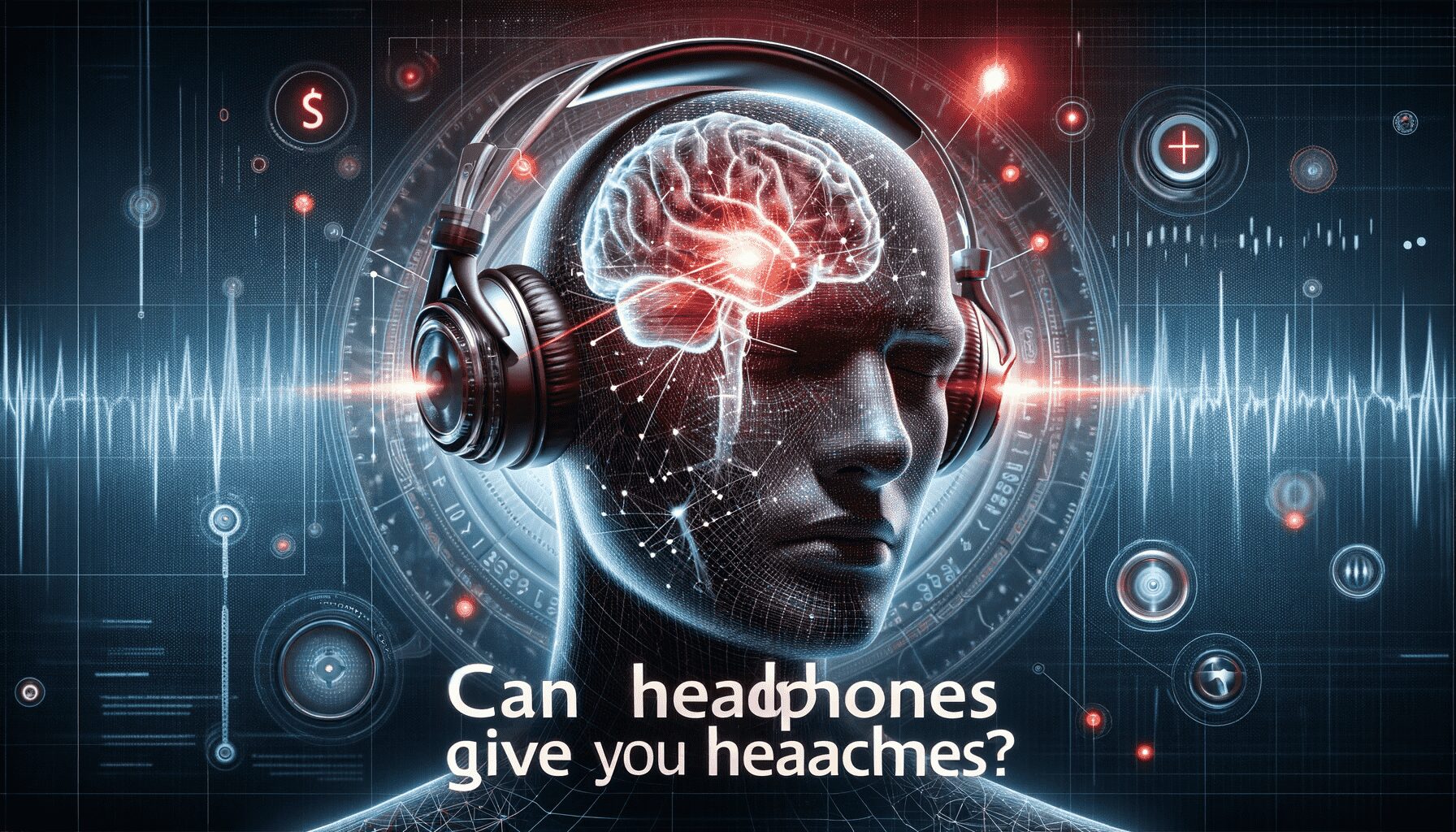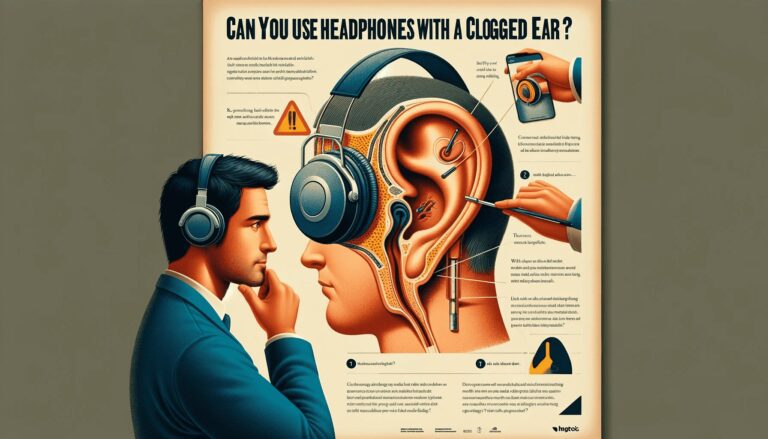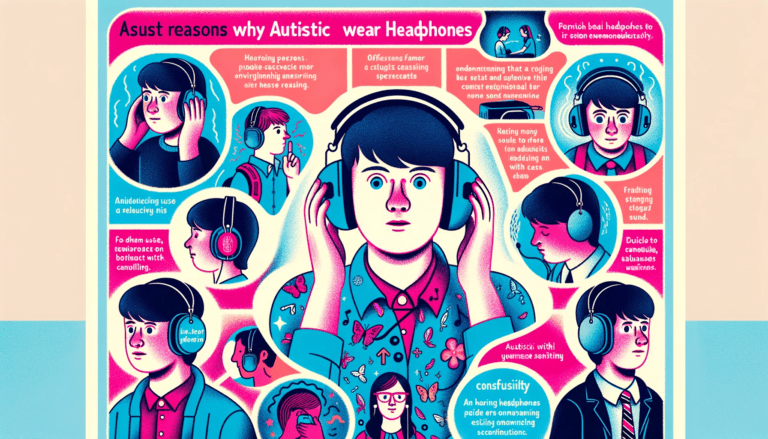Do headphones have the power to cause headaches? This question resonates with many in our digital age, where headphones are an integral part of daily life. Is there a hidden cost to wearing them for extended periods?
The answer is yes, headphones can indeed lead to headaches. Factors contributing to this include prolonged usage, high volume levels, and the physical pressure exerted by over-ear models. These aspects can strain the ears and temples, leading to discomfort and tension headaches.
In this article, we look at preventive measures, expert medical insights, and personal testimonies to provide a comprehensive understanding of what you need to know about headphones and headaches.
Understanding Headaches: Types and Triggers
Defining Headaches and Their Categories
Headaches, a common ailment affecting individuals worldwide, can be broadly classified into two main categories: primary and secondary headaches. Primary headaches are those not caused by another medical condition, while secondary headaches are the result of another underlying health issue.
Primary headaches include:
- Tension-type headaches
- Migraines
- Cluster headaches
Secondary headaches may be due to:
- Sinus infections
- Head injury
- Blood vessel disorders in the brain
Remember, identifying the type of headache is crucial for effective treatment and management.
Each category encompasses various subtypes with specific characteristics and symptoms, making it essential to understand the differences for proper diagnosis and relief strategies.
Common Triggers for Headaches
Headaches can be triggered by a variety of factors, each unique to the individual. Among the most common are environmental stimuli, such as bright lights or loud noises, which can lead to tension-type headaches or exacerbate migraines. Stress is another significant factor, often causing headaches due to the physical and emotional strain it places on the body.
Dietary choices also play a role in headache onset. For instance, certain foods and beverages, including aged cheeses, red wine, and foods high in nitrates, are known to be potential triggers. Here’s a brief list of common dietary triggers:
- Aged cheeses
- Caffeinated drinks
- Alcohol, particularly red wine
- Processed meats
Dehydration is another culprit often overlooked. Inadequate water intake can lead to a dehydration headache, characterized by a dull, throbbing pain.
Tip: Keeping a headache diary can help identify personal triggers and patterns, which is crucial for managing and preventing future headaches.
The Role of Electronics in Headache Onset
In the digital age, electronics have become ubiquitous in our daily lives, and their impact on our health is a growing concern. The use of electronic devices, especially those worn close to the head like headphones, has been associated with the onset of headaches. Prolonged exposure to screens and the electromagnetic fields (EMFs) emitted by devices can lead to digital eye strain and tension headaches.
Headphones, in particular, create a unique environment for the ears and brain. They can trap heat against the head and exert pressure on specific areas, potentially contributing to discomfort and pain. Here’s a list of ways electronics may influence headache onset:
- Direct pressure on the scalp and ears
- Heat buildup from prolonged use
- Auditory strain from high-volume levels
- Visual strain from screen glare and flickering
Tip: To minimize the risk of headaches, it’s advisable to take regular breaks from electronic devices and practice good posture. Adjusting the brightness and contrast of screens can also help reduce eye strain.
Headphone Usage: A Potential Culprit
How Headphones Can Cause Headaches
Headphones are a ubiquitous accessory in modern life, but their convenience can come with a downside. Prolonged use, especially at high volumes, can lead to headaches. The reasons are multifaceted, ranging from the direct pressure exerted on the ears and head to the auditory strain of loud noises.
Poorly designed headphones can create specific pressure points, which may result in tension headaches. This is particularly true for on-ear and over-ear models that squeeze the head, as well as in-ear buds that can irritate the ear canal. Here are some common ways headphones contribute to headaches:
- Excessive volume causing auditory nerve strain
- Tight headbands leading to scalp and temporal pressure
- The weight of the headphones causes neck strain
- Heat buildup around the ears from prolonged use
Tip: To minimize the risk of headaches, opt for headphones with adjustable bands and cushioned ear pads, and keep the volume at a comfortable level.
It’s important to recognize the signs of discomfort early and to adjust usage accordingly. By understanding how headphones can impact our well-being, we can make informed choices to protect our health while enjoying our favorite audio.
The Impact of Sound Levels on Headaches
Exposure to high sound levels through headphones can be a significant factor in the development of headaches. Prolonged listening at volumes above 85 decibels (dB) is considered harmful, and many personal audio devices can exceed this threshold. The relationship between sound levels and headaches is not merely about volume; the duration of exposure is equally critical.
- Safe Listening Levels:*
- Below 70 dB: Generally considered safe for unlimited listening.
- 70-85 dB: Safe for approximately 8 hours per day.
- Above 85 dB: Risk of hearing damage and headaches increases, with safe exposure time decreasing as volume increases.
Tip: To prevent headaches, use the 60/60 rule: listen at no more than 60% of maximum volume for no longer than 60 minutes at a time.
It’s important to be aware of the cumulative effect of daily noise exposure. Even if individual sessions are within safe listening levels, the total amount of noise one is exposed to throughout the day can lead to tension headaches or exacerbate migraine symptoms. Adjusting volume settings and being mindful of listening habits are key steps in mitigating the risk of headphone-induced headaches.
Physical Strain from Headphones
The discomfort and physical strain caused by prolonged headphone use is not just a matter of minor inconvenience; it can be a significant contributor to headaches. Headphones that are too tight can exert excessive pressure on the head and ears, leading to discomfort and pain. Conversely, headphones that are too loose may require constant adjustment, causing neck and head strain as users try to keep them in place.
Ergonomics plays a crucial role in the design of headphones. A well-designed pair will distribute weight evenly and minimize pressure points. Below is a list of common physical strains associated with headphone use:
- Pressure on the skull and ear cartilage
- Tension in the jaw from clamping force
- Neck strain from heavy headsets
Tip: To alleviate physical strain, adjust the headband so that it sits comfortably and ensure that the ear cups do not clamp too tightly. It’s also beneficial to opt for headphones with cushioned ear pads and a lightweight design.
Evaluating Headphone Design and Ergonomics
The Importance of Proper Fit
The fit of your headphones is more than just a matter of comfort; it’s a crucial factor in preventing headaches. Proper fit ensures that the headphones sit snugly without exerting undue pressure on any part of the head or ears. Ill-fitting headphones can lead to tension headaches due to constant pressure points or can exacerbate pre-existing conditions such as migraines.
Adjustability is key when selecting headphones. A good pair should allow you to modify the headband length, earcup position, and clamping force to suit your unique head shape. Below is a list of features to consider for achieving the best fit:
- Adjustable headband
- Swivel earcups
- Soft, memory foam padding
- Lightweight materials
Tip: Always try on headphones before purchasing to ensure they can be adjusted to your comfort level. Remember, what feels comfortable for a few minutes in the store may not feel the same after several hours of use.
Materials and Pressure Points
The materials used in headphone construction and the way they interact with our heads and ears can be a significant factor in whether they cause discomfort or headaches. Cushioning is one aspect that can greatly affect comfort; memory foam padding tends to distribute pressure more evenly than firmer materials. However, even with soft materials, the clamping force of headphones can create pressure points that lead to pain over time.
Ergonomics plays a crucial role in the design of headphones. Manufacturers aim to balance the need for a secure fit with the potential for causing pressure-induced headaches. Here’s a quick overview of common materials used in headphone cushions:
- Memory foam: Conforms to the shape of the head and ears, reducing pressure points.
- Leather or leatherette: Offers a premium feel but may cause sweating and increased pressure.
- Fabric: Breathable but may lack the cushioning of foam.
Tip: When trying on headphones, pay attention to the areas around your ears and the top of your head. If you feel any specific points of pressure, consider a different design or brand to avoid potential headaches.
Over-Ear vs. In-Ear: Pros and Cons
When choosing between over-ear and in-ear headphones, it’s essential to consider both comfort and the potential for causing headaches. Over-ear models typically offer superior sound quality and noise isolation, which can reduce the need to increase volume to unsafe levels—a common headache trigger. However, they can be bulky and may apply pressure to the sides of the head, which can lead to discomfort over time.
In contrast, in-ear headphones are more compact and less likely to cause physical strain due to their lightweight design. Yet, they sit directly in the ear canal, which can increase the risk of ear infections and contribute to headaches if the volume is too high or if they are worn for extended periods.
Pros and Cons at a Glance:
- Over-Ear Headphones
- Better sound quality and noise isolation
- Can be bulky and cause pressure on the head
- In-Ear Headphones
- More compact and lightweight
- Higher risk of ear infections and direct pressure in the ear canal
Tip: Always ensure a proper fit regardless of the style you choose, as this can significantly impact both the risk of headaches and your overall listening experience.
Preventive Measures and Best Practices
Choosing the Right Headphones
Selecting the right headphones is crucial for both sound quality and comfort, which can significantly affect the likelihood of developing headaches. When shopping for headphones, consider the following aspects:
- Ergonomics: Look for headphones that are adjustable and fit well. They should not exert excessive pressure on any part of the head or ears.
- Sound quality: High-quality sound can reduce the need to turn up the volume to unsafe levels.
- Battery life (for wireless models): Longer battery life means less frequent charging, which can be convenient and reduce exposure to electromagnetic fields if that is a concern.
Tip: Always test headphones before purchasing, if possible, to ensure they are comfortable and meet your sound expectations.
Remember that what works for one person may not work for another. It’s important to find headphones that suit your specific needs and listening habits. For instance, if you are prone to ear infections, consider over-ear headphones to avoid ear canal irritation. Here’s a simple checklist to help you make an informed decision:
- Comfort and fit
- Sound quality and noise cancellation
- Durability and warranty
- Additional features (e.g., microphone, controls)
- Price and brand reputation
By taking the time to research and choose wisely, you can enjoy your music or podcasts without the added risk of headaches.
Setting Safe Volume Limits
Listening to music or any audio through headphones at a high volume over extended periods is a common trigger for headaches. To prevent this, it’s crucial to set safe volume limits. The World Health Organization recommends keeping the volume below 85 decibels to avoid hearing damage, which can also help in preventing headaches.
Experts suggest the 60/60 rule: listen at no more than 60% of the maximum volume for no longer than 60 minutes at a time. Here’s a simple guideline to follow:
- 60% Maximum Volume: Keep your device’s volume at or below 60% of its maximum capacity.
- 60 Minutes Duration: Limit your listening session to 60 minutes before taking a break.
- Volume Control Apps: Consider using apps that monitor and control your volume levels.
Tip: If you can’t hear external sounds while wearing headphones, the volume is likely too high. Lower the volume until you can hear your surroundings to ensure a safer listening level.
Remember, these are general guidelines and individual tolerance levels may vary. Pay attention to your body’s signals and adjust accordingly to maintain a comfortable and headache-free listening experience.
Taking Regular Breaks
Incorporating regular breaks into your listening routine is crucial for preventing headaches. Continuous headphone use can lead to tension and fatigue, which are common headache triggers. It’s recommended to take a break every hour to give your ears and mind a rest. This practice not only helps reduce the likelihood of headaches but also enhances the overall listening experience.
- Listen for 60 minutes, then rest for at least 10 minutes.
- Stand up, stretch, or walk around during your break to improve circulation.
- Use this time to hydrate and rest your eyes, especially if you’re also looking at a screen.
Tip: Use the break to perform simple neck and shoulder exercises to relieve any built-up tension. This can be particularly beneficial for those who experience tension-type headaches.
Exercises to Relieve Tension
Incorporating simple exercises into your routine can be an effective way to alleviate the tension that often leads to headaches. Neck stretches and shoulder shrugs are easy to perform, even while seated at your desk. These movements help to loosen the muscles around the neck and shoulders, areas that commonly harbor tension during headphone use.
Gentle head tilts can also reduce stiffness. Tilt your head from side to side, holding each position for a few seconds. This exercise promotes flexibility and blood flow. Additionally, practicing good posture throughout the day can prevent the buildup of muscle strain.
Remember to take short breaks every hour to perform these exercises, as consistent practice is key to preventing tension headaches.
Here is a simple routine to follow:
- Sit up straight in your chair with your feet flat on the floor.
- Slowly tilt your head towards your right shoulder, hold for 5 seconds, then switch to the left.
- Roll your shoulders in a circular motion, 5 times forward, then 5 times backward.
- Finish with a few deep breaths, inhaling through the nose and exhaling through the mouth to relax the entire body.
Medical Insights: Expert Opinions and Studies
Research on Headphones and Headache Correlation
Recent studies have begun to shed light on the potential link between headphone use and the development of headaches. A key focus has been the duration of headphone use and the corresponding exposure to sound at various levels. Researchers are investigating whether there is a threshold of exposure that, once crossed, significantly increases the risk of headache onset.
Patterns of headphone usage and their association with headache frequency have also been a subject of interest. Preliminary findings suggest that individuals who use headphones for extended periods, especially at high volumes, may report more frequent headache episodes. However, the data is still being collected, and definitive conclusions have yet to be drawn.
Tip: To minimize the risk of headaches, consider moderating headphone usage and being mindful of volume levels.
Further research is needed to establish a clear causal relationship and to understand the underlying mechanisms. The table below summarizes some of the key aspects being studied:
| Aspect Studied | Description |
|---|---|
| Duration of Use | Examining the length of time headphones are worn and headache correlation. |
| Volume Levels | Assessing the impact of high volume on headache incidence. |
| Type of Headphones | Investigating whether over-ear or in-ear models affect headache prevalence differently. |
| User Demographics | Analyzing age, gender, and lifestyle factors to headphone use and headaches. |
Healthcare Professionals’ Recommendations
Healthcare professionals emphasize the importance of moderation when it comes to using headphones. Prolonged exposure to high volumes can lead to not only headaches but also long-term hearing damage. They recommend setting a safe volume level, ideally at or below 60% of the maximum volume, and limiting headphone usage to less than 90 minutes at a time.
Ergonomics also play a crucial role in preventing headphone-induced headaches. Medical experts suggest selecting headphones with a comfortable fit that does not exert excessive pressure on the ears or head. Features such as padded ear cups and adjustable headbands can significantly reduce the risk of headaches.
Remember to take regular breaks during extended listening sessions to give your ears and head a rest.
Here are some additional tips from healthcare professionals:
- Ensure the headphones are not too tight, as this can restrict blood flow and contribute to headaches.
- Opt for noise-canceling headphones to avoid turning up the volume in noisy environments.
- Be mindful of posture while wearing headphones, as poor neck and shoulder alignment can exacerbate headache symptoms.
Long-Term Effects of Headphone Use
Prolonged use of headphones can lead to a range of long-term effects on both hearing and overall health. Hearing loss is a significant risk, especially when high volume levels are maintained over extended periods. This can result in a condition known as Noise-Induced Hearing Loss (NIHL), which may be temporary or permanent.
Other potential long-term effects include:
- Tinnitus, is a persistent ringing or buzzing in the ears
- Hyperacusis, is an increased sensitivity to certain frequencies and volumes
- Auditory fatigue, which can lead to difficulties in concentration and increased stress levels
It’s also important to consider the physical implications of wearing headphones for long hours. Poorly designed headphones can cause discomfort and may lead to chronic pain in the head, neck, or ears due to pressure points.
Tip: To minimize the risk of long-term effects, it’s crucial to choose headphones with ergonomic design, take regular breaks, and maintain a moderate volume level.
Personal Stories: Testimonials and Case Studies
Individual Experiences with Headphones and Headaches
Personal anecdotes often shed light on the nuanced relationship between headphone use and headaches. Many individuals report a clear onset of headaches after prolonged periods of wearing headphones, especially when the volume is high or the fit is tight. For some, the discomfort begins as a dull ache around the ears, escalating to a full-blown headache with continued use.
- Pressure: Users with over-ear headphones often mention the clamping force as a headache trigger.
- Volume: A common theme is the correlation between loud volumes and the severity of headaches.
- Ergonomics: In-ear headphones are sometimes blamed for causing inner ear discomfort leading to headaches.
Tip: To mitigate headphone-induced headaches, start by lowering the volume and ensuring a comfortable fit. If discomfort persists, consider taking a break or switching to a different headphone style.
These experiences, while subjective, are valuable for understanding the potential impact of headphone design and usage on our well-being. They also highlight the importance of listening to our bodies and responding to discomfort before it escalates.
Recovery and Management Tales
The journey to recovery and management of headaches associated with headphone use is as unique as the individuals experiencing them. Many have found relief through a combination of lifestyle changes and ergonomic adjustments. For instance, Julia, a graphic designer, noticed a significant reduction in her headache frequency after switching to lighter, over-ear headphones and incorporating neck stretches into her daily routine.
Key strategies employed by others include:
- Mindful listening habits, such as limiting exposure to loud volumes
- Regular breaks to reduce auditory and physical strain
- Alternative entertainment sources to give the ears a rest
Tip: Always listen to your body’s signals. If you experience discomfort while using headphones, take immediate action to adjust or remove them.
These anecdotes underscore the importance of personalized approaches to headache management. While one solution may work for some, others may require a different strategy or a combination of methods to find relief.
Lifestyle Adjustments for Headache Prevention
In the quest to prevent headaches, lifestyle adjustments play a pivotal role. Beyond the choice of headphones, daily habits and routines can significantly influence the frequency and severity of headache episodes. Embracing a holistic approach to health can lead to substantial improvements.
- Regular exercise helps in promoting overall well-being and stress reduction, which can be beneficial in preventing tension-type headaches.
- Adequate hydration is essential, as dehydration is a common headache trigger.
- Maintaining a consistent sleep schedule ensures proper rest and can help in reducing the likelihood of headache onset.
- Mindfulness practices such as meditation or yoga can also be effective in managing stress levels.
Tip: Integrating these lifestyle changes gradually can make them more sustainable and less overwhelming. It’s important to listen to your body and adjust your routines to what feels right for you.
Conclusion: Balancing Enjoyment and Health
In summary, understanding the connection between headphones and headaches is crucial for maintaining both auditory and overall health. By being mindful of volume levels, wearing time, and choosing the right type of headphones, individuals can enjoy their audio experiences without compromising their well-being.
Remember, prevention is key—taking regular breaks and listening at safe volumes can help minimize the risk of headaches and protect your hearing. It’s important to listen to your body and seek medical advice if you experience persistent discomfort. Ultimately, a balanced approach to headphone use is the best way to ensure a harmonious relationship between your favorite tunes and a pain-free listening experience.
Frequently Asked Questions
Can wearing headphones cause headaches?
Yes, wearing headphones for extended periods or at high volume levels can contribute to headaches due to factors like sound pressure and physical strain on the head and ears.
What types of headaches are commonly associated with headphone use?
Tension headaches and migraines are the most common types of headaches that can be triggered or worsened by prolonged headphone use, especially if the headphones are poorly fitted or the volume is too loud.
How does the design of headphones affect the likelihood of getting a headache?
Headphones with a tight fit can exert pressure on the head and ears, leading to discomfort and headaches. Additionally, materials that cause skin irritation or are heavy can also contribute to headache onset.
Are in-ear or over-ear headphones better for preventing headaches?
This can vary from person to person. Over-ear headphones typically distribute pressure more evenly and can be more comfortable for long-term wear, while in-ear headphones are lighter but may cause more direct ear canal pressure.
What are some tips for using headphones without causing headaches?
To avoid headaches, choose well-fitted headphones, set a safe volume limit, take regular breaks to rest your ears and head, and do exercises to relieve neck and head tension.
Should I consult a doctor if I experience headaches from headphone use?
If you frequently experience headaches after using headphones, it’s advisable to consult a healthcare professional to rule out other causes and to discuss safe headphone use practices.




